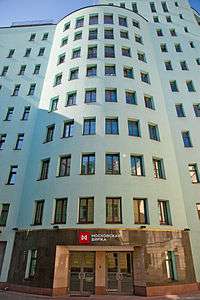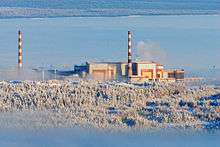Moscow Exchange
Coordinates: 55°45′19″N 37°36′22″E / 55.75528°N 37.60611°E
 | |
 | |
| Type | Stock exchange, Futures exchange, FX exchange |
|---|---|
| Location | Moscow, Russia |
| Founded | 19 December 2011 |
| Owner | Public company |
| Key people | Alexander Konstantinovich Afanasiev (CEO) |
| Currency | Russian ruble |
| Market cap | RUB 259 bln on November, 2016 |
| Indices | MICEX Index, RTS Index |
| Website |
moex |
Moscow Exchange (Russian: ПАО Московская Биржа; latinization: PAO Moskovskaya Birzha), the largest exchange group in Russia, operates trading markets in equities, bonds, derivatives, the foreign exchange market, money markets and precious metals. The Moscow Exchange Group also operates Russia's central securities depository (National Settlement Depository) and the country's largest clearing service provider (National Clearing Centre).[1] The exchange was established in December 2011 by merging the Moscow Interbank Currency Exchange (MICEX) and the Russian Trading System.
History
Moscow Exchange was established on 19 December 2011 by merging the two largest Moscow-based exchanges, the Moscow Interbank Currency Exchange (MICEX) and the Russian Trading System (RTS), hence the name "Moscow Exchange MICEX-RTS".[2] Both organisations had been formed in the 1990s and were the leading Russian exchanges for two decades with their MICEX Index and the RTS Index. The merger created a single entity[2] and advanced Russia's plans to turn Moscow into an international financial centre.[3] The exchange rebranded in July 2012.[2][4]
The exchange completed its Initial Public Offering (IPO) on 15 February 2013, raising 15 billion rubles (approximately $500 million).[5] The IPO, at the time the largest ever held exclusively in Moscow, was more than twice oversubscribed and drew demand from institutional investors globally. The Exchange’s shares were included in the MSCI Russia Index as of 26 November 2013.[6] In July 2014 the Central Bank of Russia, the largest shareholder of the exchange, completed the public sale of shares representing nearly 12% of the exchange.[7] A Russian federal law requires the Central Bank to fully sell its stake in the exchange by 1 January 2016.[8]
Management
The Executive Board consists of 5 members:
- CEO Alexander Afanasiev (*1962),[9] Chairman of the MICEX FX Market Council in 2005-2012, co-chairs the National Foreign Exchange Association and National Securities Market Association
- Deputy CEO as of October 2012 Andrey Shemetov (*18 July 1974), former CEO of the brokerage firm Aton,[10]
- Chief Information Officer (CIO) Sergei Poliakoff, a 20-year veteran of the securities industry who joined Moscow Exchange October 2012,[11]
- Chief Financial Officer (CFO) Evgeny Fetisov (*1975), since February 2013 , a seasoned financial professional formerly of Citibank, McKinsey & Co. and Da Vinci Capital Partners.
- Chief Operating Officer Dmitry Shcheglov (*1975), a veteran of Moscow Exchange and its predecessor MICEX.
The Head of Risk & Clearing in September 2013 is Luis Vicente, former risk manager at Brazil’s BM&F Bovespa.[12]
Since 2016, the Supervisory Board consists of 12 instead of 15 members previously. Alexei Kudrin, a former Russian Deputy Prime Minister and Finance Minister was elected Chairman of the Moscow Exchange Supervisory Board in June 2014.[13]
For 2016-2017 the Board consists of the following members
- Chairman Alexei Kudrin, former Finance Minister and Deputy Prime Minister of Russia,
- Alexander Afanasiev, CEO of Moscow Exchange,
- Sean Glodek, Deputy CEO of the Russian Direct Investment Fund
- Andrey Golikov, a Board Member at National Clearing Centre,
- Maria Gordon, a former emerging market portfolio manager at Goldman Sachs and PIMCO
- Valery Goreglyad, Chief Auditor of the Bank of Russia,
- Yuriy Denisov, National Research University – Higher School of Economics, Institute for Statistical Studies and Economics of Knowledge,
- Anatoly Karachinsky, Co-founder and Chairman of the Board at IBS Group (a leading IT services provider in Central and Eastern Europe),
- Duncan Paterson, a consultant
- Rainer Riess, Director General of the Federation of European Securities Exchanges (FESE),
- Yuan Wang, former Chief Economist at China Development Bank,
- Bella Zlatkis, Deputy Chairman of the Management Board at Sberbank, former Deputy Finance Minister of Russia,
Shareholders
Moscow Exchange’s shares are publicly traded under the ticker MOEX. As of April 2016 approximately 57% of shares were in the free float, while the following held blocks of shares: Central Bank of Russia (11.75%),[14] Sberbank (9.9%), Vnesheconombank (8.4%) and European Bank for Reconstruction and Development (EBRD) (6.1%).
Trading markets
Equity & Bond Market
The Equity & Bond Market is a key platform for Russian businesses to raise capital and for domestic and international investors to access equity and debt investment opportunities. The marketplace is the main trading venue for Russian stocks as well as government, municipal, and corporate bonds. In 2013-2014, 16 companies placed stock via Moscow Exchange, raising a total of approximately RUB 200 bln. On the fixed income side, more than 400 bond issues were placed, raising more than RUB 3.4 trln for issuers.
Moscow Exchange includes shares of many of Russia’s largest companies including Gazprom, Sberbank, Rosneft, Lukoil and VTB .
Most global investment banks began to provide their clients with DMA to the Russian market in 2013.[15] As a result of regulatory changes, the international central securities depositories Euroclear and Clearstream now offer settlement services for Russian stocks and bonds.[16]
In addition to attracting international investors to trade on its platform, Moscow Exchange is focused on further developing the domestic investor base. Recent changes to the regulation of pension funds, together with changes to the listing rules, allow more assets of non-state pension funds to be invested into the market. Other legislative changes incentivise retail investors through reduced taxation to invest into stocks and bonds.[17]
Foreign Exchange and Money market
Moscow Exchange's FX and Money Market is a key element of the Russian financial system. The Bank of Russia uses the Exchange's infrastructure to implement monetary policy and provide liquidity to the market through repo transactions and FX swap transactions. For its domestic and international clients, including banks and corporates, Moscow Exchange offers a range of products to manage liquidity and FX exposure. It is the centre of pricing for RUB and offers many RUB currency pairs, all with tight spreads based on a transparent order book.[18]
FX Market All transactions (spot and swap) on the FX market are centrally cleared by National Clearing Centre. In September 2014, average daily trading volume across all currency pairs was USD 22.4 bln.[19]
While RUB/USD and RUB/EUR remain the most traded currency pairs, Moscow Exchange also actively promotes trading in other currencies. In particular the RUB/CNY pair has been well received by the market[20] and trading in the GBP and HKD were launched in late 2014.[21]
Derivatives market
Moscow Exchange is one of the 10 largest exchange platforms for derivatives trading globally.[22] The Derivatives Market facilitates trading of options contracts on, as well as futures contracts on indices, shares of both Russian and foreign companies, currency pairs, precious metals, energy and agricultural products.[23]
Futures on the RTS Index ranked sixth among the world's most actively traded derivatives on stock market indices according to data from the Futures Industry Association as of June 2014. Futures contracts on the U.S. dollar-Russian ruble are ranked first in global liquidity, according to the Futures Industry Association.[24]
As of October 2014, 58 types of futures and 18 types of options are traded on the Exchange.[25]
Commodities markets
Precious metals trading
Moscow Exchange introduced spot trading in gold and silver in 2013. It has postponed a launch of trade in platinum and palladium by end of October or early November 2014 in order to do additional testing of the trading and clearing system.[26]
Grain trading
National Mercantile Exchange is Russia’s platform for spot grain trading, as well as in deliverable futures on agricultural products. Since 2002, National Mercantile Exchange has been the platform by which the Russian state executes interventions in the grain market.[27]
Post-trade services, subsidiaries
Moscow Exchange subsidiary National Settlement Depository (NSD) was granted status as Russia’s Central Securities Depository in 2012. Subsequently Euroclear and Clearstream opened accounts with the NSD, allowing international investors access to Russian bonds and equities.[28] Another Moscow Exchange subsidiary, National Clearing Centre (NCC), is Russia’s largest clearing center and is the Central Counterparty (CCP) across all Moscow Exchange markets.
See also
- Russian Trading System (RTS) Stock Exchange historic, merged 2011
- Moscow Interbank Currency Exchange historic, merged 2011
- Moscow International Business Center, a commercial district in Moscow
References
- ↑ "Moscow Exchange". Moscow Exchange.
- 1 2 3 "Micex and RTS merger creates Russian Exchange powerhouse". newswire.ca. 2011-12-19.
- ↑ "Russia's Micex and RTS set to complete merger". Financial Times (subscription only).
- ↑ "Russian Stock Exchange Gets New Name". RIA Novosti. 3 July 2012.
- ↑ "Themes of the week - Moscow Exchange". Kommersant. 2013-02-18.
- ↑ "LSR Group, Inter RAO, TMK Tumble on MSCI Deletion: Moscow Mover, Ksenia Galouchko". 2013-11-08.
- ↑ "Russian Stocks Stagnate, but Moscow Exchange Shares Soar". Institutional Investor. 2014-07-09.
- ↑ "Russian central bank decides to sell Moscow Exchange shares". Reuters.com. 1 July 2014. Retrieved 27 August 2014.
- ↑ "Management- Moscow Exchange". Moscow Exchange. Retrieved 4 March 2014.
- ↑ "Change in Management and Board". Finparty. 2012-10-26.
- ↑ "Sergei Poliakoff". ITAR-TASS. 24 May 2013.
- ↑ "Exchange has summoned Brazilian for help". RBC Daily. 4 September 2013.
- ↑ "Moscow Exchange Supervisory Board Resolutions". Moscow Exchange. 2014-06-26.
- ↑ "On OJSC Moscow Exchange shares selling price". Bank of Russia. 2014-07-02.
- ↑ "Global banks battle Russian brokers for equties trading". Financial News. 2013-09-05.
- ↑ "Russia Stocks Erase Gain on Poroshenko Warning as Sistema slides". Bloomberg. 2014-09-18.
- ↑ "Moscow Exchange". Moscow Exchange.
- ↑ "About the FX Market". Moscow Exchange.
- ↑ "Moscow Exchange September Forex turnover jumps 10% MoM and 28.1% YoY". Leap Rate. 2014-01-10.
- ↑ "Chinese yuan trading volume up 60% in September on Moscow Exchange". Financial. 2014-10-04.
- ↑ http://www.profit-loss.com/node/28009
- ↑ "World Federation of Exchanges - Monthly Reports".
- ↑ "Futures Market Instruments".
- ↑ "Trading Volume". Futures Industry. 2014-09-16.
- ↑ "Moscow Exchange". Moscow Exchange.
- ↑ "Moscow Exchange launches trading in precious metals". Moscow Exchange. 2013-10-21.
- ↑ "National Mercantile Exchange".
- ↑ "Project "South Stream" cannot be stopped, said the head of Gazprom Invest". Business-Tass. 2013-12-03.


